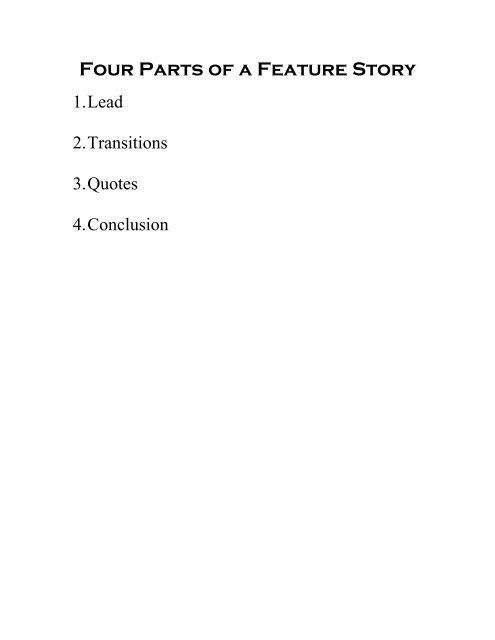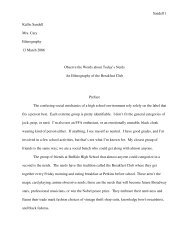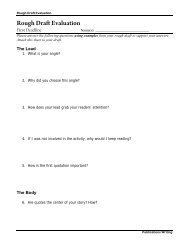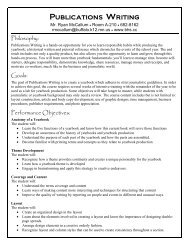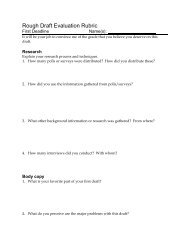Four Parts of a Feature Story
Four Parts of a Feature Story
Four Parts of a Feature Story
Create successful ePaper yourself
Turn your PDF publications into a flip-book with our unique Google optimized e-Paper software.
<strong>Four</strong> <strong>Parts</strong> <strong>of</strong> a <strong>Feature</strong> <strong>Story</strong><br />
1. Lead<br />
2. Transitions<br />
3. Quotes<br />
4. Conclusion
Lead<br />
Purpose: To catch a reader’s attention and make them<br />
want to read on while introducing your story’s topic and<br />
angle.<br />
How do you do this<br />
• By using your most creative, descriptive writing in<br />
“setting the scene”<br />
• By keeping it short, but still introducing the topic. (1 to<br />
2 sentences)<br />
• By building suspense and saving some information for<br />
later.<br />
• By rewriting, rewriting, rewriting.
Transitions<br />
Purpose: To help the reader move smoothly through the<br />
story by trying together each topic.<br />
How do you do this<br />
• By creating an outline grouping together similar ideas<br />
and topics.<br />
• By presenting important background information<br />
gained through research, interviews, polls, and<br />
surveys.<br />
• By paraphrasing information told to you by sources<br />
that isn’t intriguing enough to be a quote.<br />
• By referring to an upcoming quote, restating the idea<br />
or opinion presented.
Quotes<br />
Purpose: To engage the reader’s interest by presenting<br />
someone’s unique perspective.<br />
How do you do this<br />
• By using effective questioning techniques in<br />
interviews.<br />
o By focusing on questions dealing with “how” and<br />
“why”<br />
o By asking intriguing, open-ended questions<br />
• By allowing your source to speak. You should only<br />
speak about 20% <strong>of</strong> the time during an interview.<br />
• By soliciting anecdotes, personal stories, and<br />
opinions.<br />
• By only selecting quotes that are unique; avoiding<br />
mundane, predictable responses.<br />
How to write a quote:<br />
“I dive a bus,” said Bus Driver Bip Smith. “It’s the most<br />
important and underappreciated job in the world.”<br />
“Stop whining,” said Senior Fib Bibble, “and get to work.”
AVOID OBVIOUS, PREDICTABLE QUOTES:<br />
“I was really excited when I was chosen Homecoming<br />
queen,” said Sheila Shellshocked.<br />
“The football team was great this year,” said Captain<br />
Bart Biceps, “even if we didn’t win a game.”<br />
“We all worked together as a team and became a<br />
family,” said Senior Sally Smiley.<br />
“Math can be fun,” said Math Teacher Mr. Cal Q. Luss,”<br />
if you work hard.”<br />
AVOID POTENTIALLY OFFENSIVE QUOTES:<br />
“I go to volleyball games because <strong>of</strong> all the hot chicks in<br />
tight spandex shorts,” said Senior Danny Drooler.<br />
“The only reason I failed math was because Mr. Luss<br />
sucks,” said Freshman Farrah F. Failure.<br />
“I heard that the main reason the football team was so<br />
bad was because Bart Biceps was whacked out on<br />
steroids,” sad A. Nonymous Student.
Conclusion<br />
Purpose: To leave your reader with a strong final<br />
impression <strong>of</strong> your story and its angle.<br />
How do you do this<br />
• By quickly summarizing your main idea (about one<br />
sentence)<br />
• By referring back to a device used in your lead<br />
• By relying on a unique quote that “says it all”<br />
• By avoiding predictions for next year, “cheerleading”,<br />
or “words <strong>of</strong> wisdom”
Sample Lead-Transition-Quote <strong>Story</strong><br />
Gotcha!<br />
The lighter side <strong>of</strong> teaching reveals teacher mishaps and unique pranks<br />
A group <strong>of</strong> students crept quietly out <strong>of</strong> the English room. After shutting the<br />
door, the class surveyed its handiwork and snickered collectively. Crouched<br />
around the corner, they hid with anxiety. Moments later, the teacher’s scream<br />
echoed through the hallway.<br />
Although academics came first, friendly pranks between students and<br />
teachers remained strikingly visible at BHS. Of teachers surveyed, 60 percent said<br />
they pulled pranks on other teachers. A variety <strong>of</strong> stories sat on the tip <strong>of</strong> each<br />
teacher’s tongue, waiting to be shared.<br />
“On my birthday, a bunch <strong>of</strong> teachers decorated my room with blinking<br />
purple lights, Vikings decorations and anything else that may be purple,” said<br />
Writing and Mass Media Teacher Mrs. Vicki Cary. “I have since learned to be<br />
less blatant about my support for the Packers.”<br />
While half <strong>of</strong> the teachers surveyed felt that their level <strong>of</strong> experience played<br />
a role in targeting, the other half disagreed. Sense <strong>of</strong> humor and comfort levels<br />
may have played larger roles than experience alone.<br />
“I believe that pranks are pulled on teachers by students who are<br />
comfortable with them,” said Band Director Mr. Lee Kjesbo.<br />
“While pranks remained avid, embarrassing moments proved even more<br />
abundant. Of teachers surveyed, 87 percent said they endured at least one<br />
embarrassing moment in their career.<br />
“In a rush to get stuff out <strong>of</strong> a file cabinet, I pulled two drawers out at the<br />
same time, and the whole thing tipped over on me. A container <strong>of</strong> fluid slid <strong>of</strong>f and<br />
broke all over the floor,” said Science Teacher Mr. Boyd Emmel. “The cabinet<br />
remained on top <strong>of</strong> me until two students pulled it <strong>of</strong>f <strong>of</strong> me.”<br />
“I started my hair on fire during a ninth grade science demonstration,” said<br />
Science Teacher Mrs. Barbara Fjelstad. “Fortunately, I was able to put it out<br />
without too much damage, and I turned the incident into a safety lesson when using<br />
an open flame with long hair.”<br />
All joking aside, the school’s open environment made embarrassing<br />
moments and friendly pranks commonplace, while keeping a fun learning<br />
environment for students. Memories <strong>of</strong> pranks and entertaining moments remained<br />
etched into the minds <strong>of</strong> students and teachers alike.<br />
“I can teach Julius Caesar and I can have one embarrassing moment,” said<br />
English Teacher Mrs. Karen Swenson. “Of course, the students only remember<br />
that one embarrassing moment.”<br />
-By Shayla Wilson and Philip Mackey


